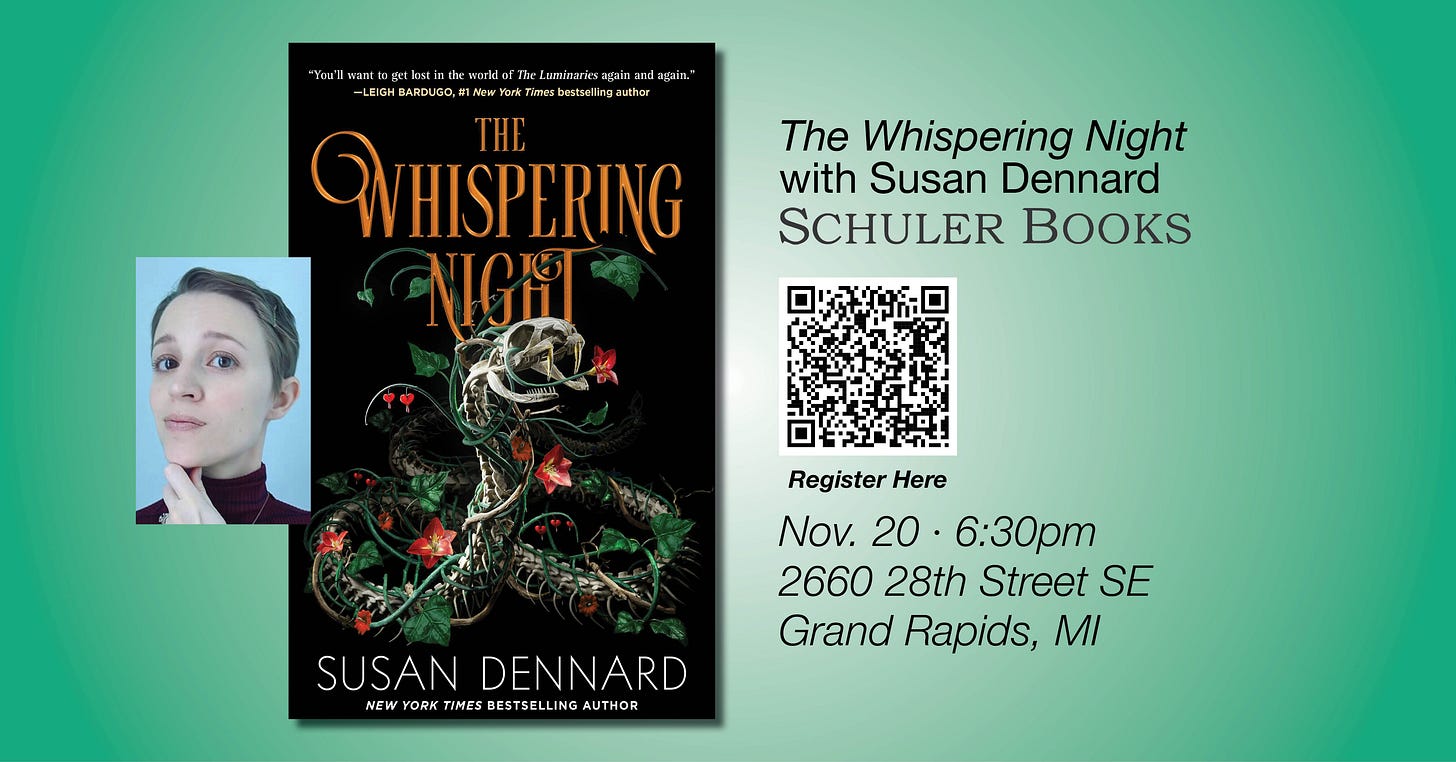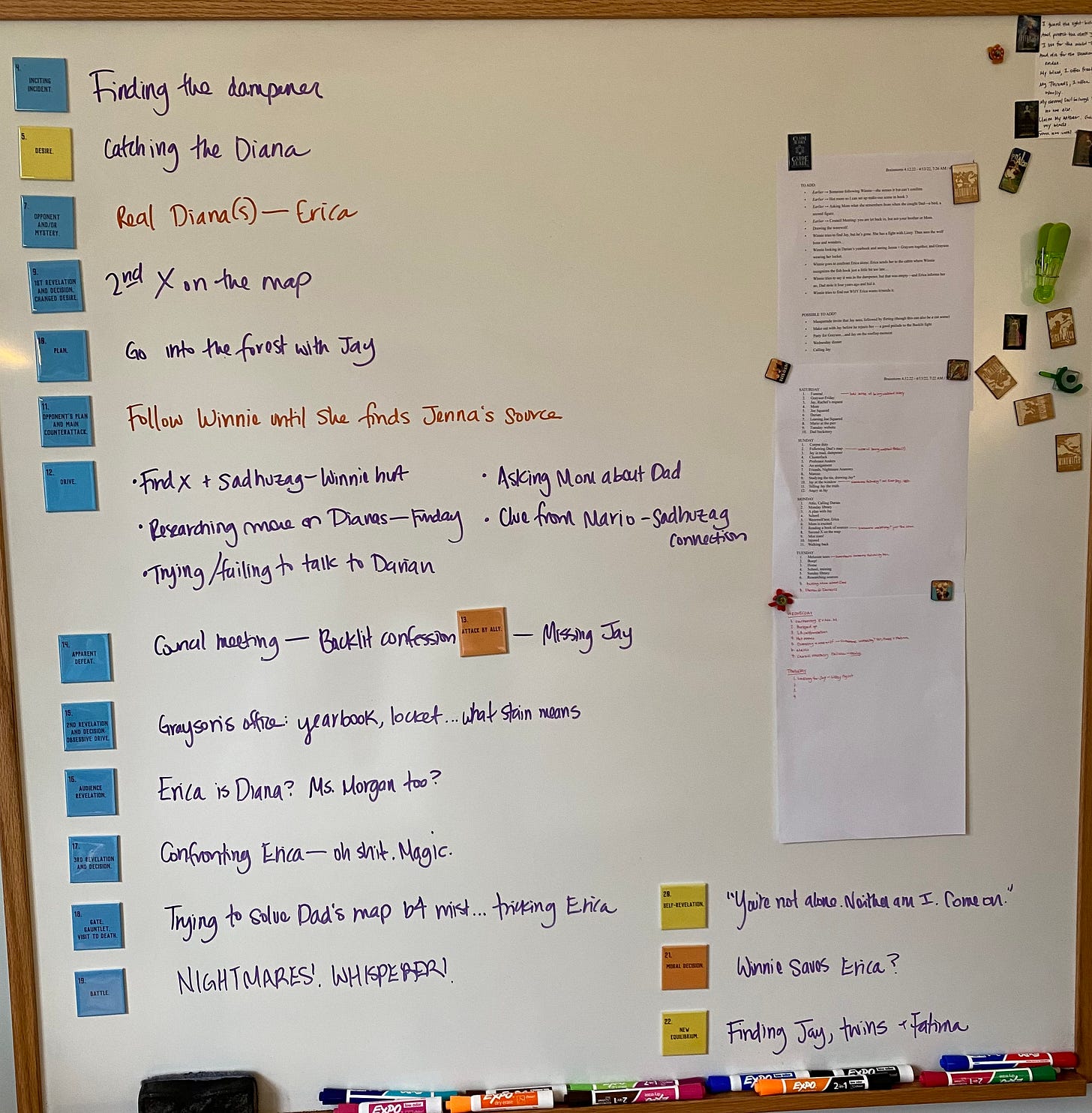Standing out in a crowded market
As well as a short review of the reMarkable Paper Pro + an intro to my brainstorming tools
Latest News from the Desk of Sooz
Just a few quick updates before we dive into the meat of this newsletter!
The Whispering Night hits stores in less than a month! I hope you’ll consider pre-ordering. ☺️
US links to pre-order are here, as well as the pre-order giveaway!
Get a signed US copy, with the giveaway enamel pin! Ships internationally.
I’m not doing many events this year because of deadlines, but I will be in Michigan and Miami!
November 20: Schuler Books in Grand Rapids, MI at 6:30
November 23: Miami Book Fair
Don’t forget to vote, my fellow Americans! ‘Tis the season, and if you’re not registered, it’s still not too late! I know it feels like our voices don’t matter, but that’s not true. The power comes when we all participate and we all exercise our right to dictate the future of our country.
Now, onto a quick review of the reMarkable Paper Pro and some of YOUR questions answered!
The reMarkable Paper Pro
Before I dive in to answering some questions from the AMA, I wanted to offer a quick comment on the reMarkable Paper Pro.
A number of you emailed or commented on my review of the reMarkable 2 wondering how I felt about the Paper Pro when it released. And to be honest, I couldn’t answer initially because I’d never used the device!
But in the last month, I have gotten to play around with one, and…Well, I can safely say: I don’t like it.
In order to accommodate the new technology, it has a completely different screen and marker. And guys, it just doesn’t feel the same. It doesn’t feel like paper in the same way that the reMarkable 2 does.
Since I don’t need color and I don’t need a backlight (although I will admit, I would love to have that feature!), I see no reason to change devices. I would much rather have the authentic pen-to-paper feel that my reMarkable 2 provides than give that up in exchange a color and light.
Also, the cost is astronomical! Not only is the actual device more expensive, but you can’t use the marker and folio you might already have because they aren’t cross compatible with the Paper Pro…
Basically, I’m very happy I didn’t buy the new device out of sheer curiosity or FOMO. My reMarkable 2 continues to be my most-used device, second only to my laptop. I highly recommend if you want to replace pen and paper—but I can’t recommend the Paper Pro in the same way.
EDIT (10/28/24): The person whose reMarkable Paper Pro I trialed actually ended up returning it! He found the screen wasn’t bright enough and the colors weren’t sharp enough, particularly during daytime/sunlight use.
My Brainstorming Tools
Amanda asked:
Hi Sooz! Do you use Miro or any similar brainstorming software?
I do not, Amanda! I’ve never even heard of that software. I prefer to brainstorm by hand or by voice, and the tools I rely on for that are (in no particular order):
My reMarkable 2
For mind mapping and stream-of-consciousness typing
A magnetic whiteboard with custom-made magnets of John Truby’s 22 plot steps, as well as the steps of the Nutshell Technique
Also for mind mapping, and for creating a bird’s-eye view of the story with my magnets
I take photos of every whiteboard I fill up and keep those images organized albums on my phone/the cloud—so like, every whiteboard I’ve ever made for Witchlight is in an album (with 86 photos in total, I you want to know!)
The Otter app
For verbal brainstorming, especially if I’m driving or my hands are full but I want to keep thinking
I also like to just talk out ideas sometime, as if there is a person there as a sounding board
SimpleNote app
I have this app across all my devices, and it’s useful for capturing ideas as they randomly strike
If I’m unable to type, then I’ll record quick thoughts into Otter and later add those ideas to SimpleNote
I know some people get a lot out of brainstorming on a computer, but it’s just not how my brain works. The time it takes me to make a mind map in software is slower than on whiteboard or my reMarkable. I also just can’t get that same bird’s-eye view from a screen that I get from a big whiteboard.
But if any of you reading this have had success with a brainstorming software, please leave a comment and share!
Standing Out in a Crowded Market
Abigail asked:
being an established author definitely came with its own share of challenges during the pandemic, but I was wondering if you have any insight for people who are (still) querying post-pandemic? It seems harder and harder to get any attention, so how can we put our best foot (story) forward?
You’re right, Abigail: it is getting harder and harder to get attention. Not just from agents and editors, but also with readers. Times have changed so much since I first signed with my agent fourteen years ago.
On the publishing side, we have fewer and fewer imprints as well as fewer and fewer employees tasked with more and more responsibilities. I feel so much sympathy for the people who work in publishing.
On the reader side, discoverability has been taken over by apps and their algorithms. I can’t even get my own followers to see my social media content because that’s not how the algorithms work now. And I actually have followers and readers and an audience! What are debuts—in traditional or indie—supposed to do?! (I don’t have an answer.)
Plus, the markets are badly saturated, and that is only worsening in the age of AI. Readers have far more reading material than they even want to choose from, and it’s getting so difficult to stand out.
So basically, I have no easy answer for you Abigail, because there is no easy fix.
The rules of cracking into publishing remain the same: write a great query letter; research agents and their current wishlists; and work on the next book while you wait.
Lest I sound like I am despairing about the current circumstances, I want to make it clear I am actually really hopeful about the future of books. Because what’s happening right now for publishing and readers is not sustainable. Something will have to give, and when it does, new opportunities will arise.
Maybe those opportunities will be new forms of publishing that allow employees to have more freedom and better pay. Maybe there will be new pathways for authors to reach readers beyond just the two big umbrellas of “traditional” or “indie.” Maybe there will be new technologies or media formats or a re-commitment to reclaiming some of the old methods from way back when, when publishing ran in a more sustainable fashion.
I have no idea, honestly. But that’s also how it’s always been. There have never been guarantees in this industry. There has never been stability. It has always been a business of speculation and trying to control the uncontrollable.
All you can control is your writing. Get better. Push your craft. Write more. And then push your craft even harder and write even more.
Eventually, the markets will shift and publishing will shift with them. When that time comes—if you're lucky break still hasn’t hit—you’ll have increased your odds of success by having a stellar product to sell. Or maybe many stellar products to sell, depending on how much you’ve kept your head down and focused on the words on the page.
That has certainly been my own strategy in recent years: I can’t make my book go viral on TikTok. I can’t bring back the Twitter of yore. I can’t force Instagram to actually show my posts to my followers.
All I can do is write and make sure that what I write is getting better with each new manuscript.
Maybe some of what I write will never see the light of day, but at least I enjoyed the process, right? At least I accepted what was in my control and what wasn’t, and I didn’t let that uncontrollable bit get me down.
In other words: I have no regrets for the books I’ve never sold because I have never written something I didn’t want to write. And, just because I don’t sell something now doesn’t mean I never will.
Or just because readers don’t connect with a book’s release now doesn't mean they never will.
Or just because you don’t get an agent with this book or the next or the ninth doesn’t mean you never will.
Nothing I suggest will guarantee that you stand out. You can research agents even more than I know you already do now. You can revise your query letter a million more times. You can write to trends or try to highlight them in your pitch, but still none of those strategies will guarantee anything.
Nor will, honestly, writing a really good book. But at least you control that part of the process. At least the joy of writing is what brought you to this field in the first place, and savoring that joy will never be a bad thing.
So much of this industry boils down to lucky timing—right desk, right moment. Right trend, right shelf. I can’t control that. You can’t control that. But we can keep working to improve the words on the page and focus on enjoying that glorious, storytelling time while we’re there.
Until next time, friends!
💚 - Sooz




I'm so glad you mentioned your experience about the reMarkable Paper Pro +. I gave in to my desire for the reMarkable 2 after reading your review and I love it. The two things I've been wishing it had was color and a light. But I am so glad I went for it. No more wasting tons and tons of paper. I'm just as happy editing on the reMarkable as on paper. I felt a little queasy seeing the release of the Paper Pro +since it had both things I wanted... but yeah the price. I feel so much better now and will remain content with what I have and maybe buy a clip on light. Much appreciated!
Great advice/reminder about sticking to what we control: working on the writing. Keeping our head down and doing the work and not paying attention to all the algorithm/social media/trends garbage. Worth my subscription.